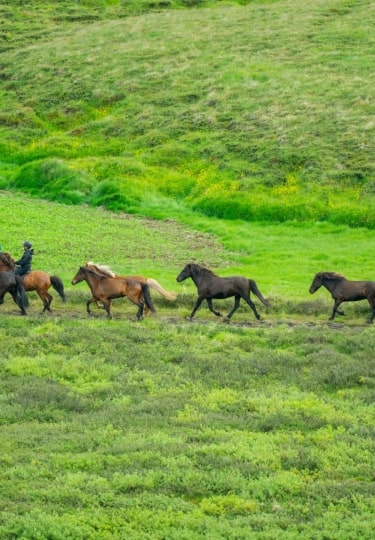Both Iceland and Greenland are amazing destinations to visit, each with its own character, culture, and cuisine. Although they have some similarities in their Viking history, weather, and rugged terrain, Iceland and Greenland are very different places.
So which is it to be? Read on to discover the pros and cons of Iceland vs. Greenland and see which fulfills the Arctic vacation of your dreams.
Weather & Best Time to Visit
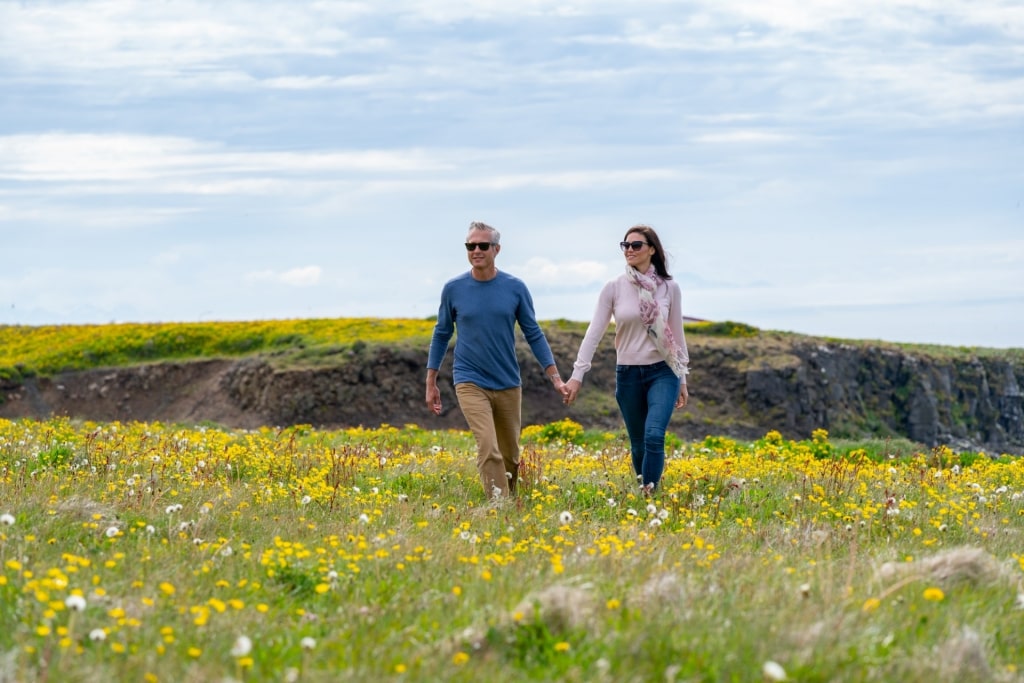
Grimsey Island, Iceland
Although both countries see harsh winters and cool temperatures throughout the year due to their northerly locations, Iceland tends to be slightly milder.
The short summer season is the best time to visit both destinations for enjoying outdoor activities like hiking and kayaking, and longer days; in midsummer, the sun barely dips below the horizon. Travel in June if you want to witness this phenomenon.
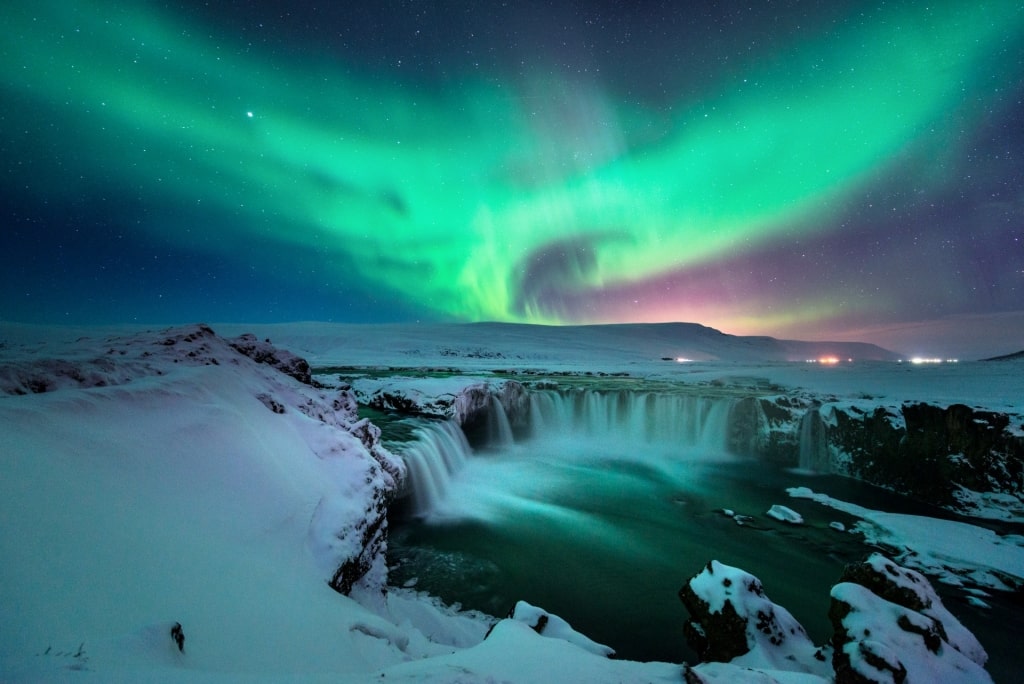
Northern Lights in Iceland
Later in the season, towards September, when the days are shorter, you could be lucky enough to see the Northern Lights.
On average, Iceland in the summer is usually between 50 and 60 degrees Fahrenheit. Depending on if you travel to northern or southern Greenland, summer temperatures typically fluctuate between the 40s and 60s, with the southern region on the warmer end.
Iceland tends to experience higher levels of rain than Greenland, with spring being wetter than summer, fueling the many waterfalls. It can also be very windy in Iceland.
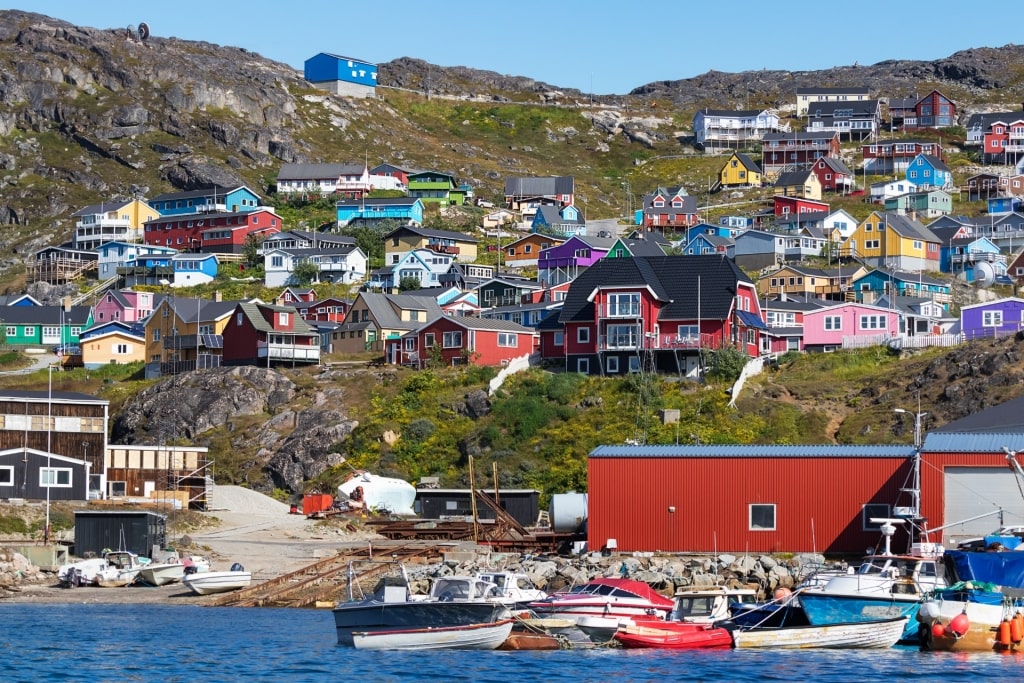
Qaqortoq, Greenland
Greenland has a drier climate in general, with low humidity. Neither destination is somewhere you should expect to sit on the beach; instead, pack walking boots and waterproofs and prepare to experience the elements.
Read: What to Pack for Iceland
Transportation & Getting Around
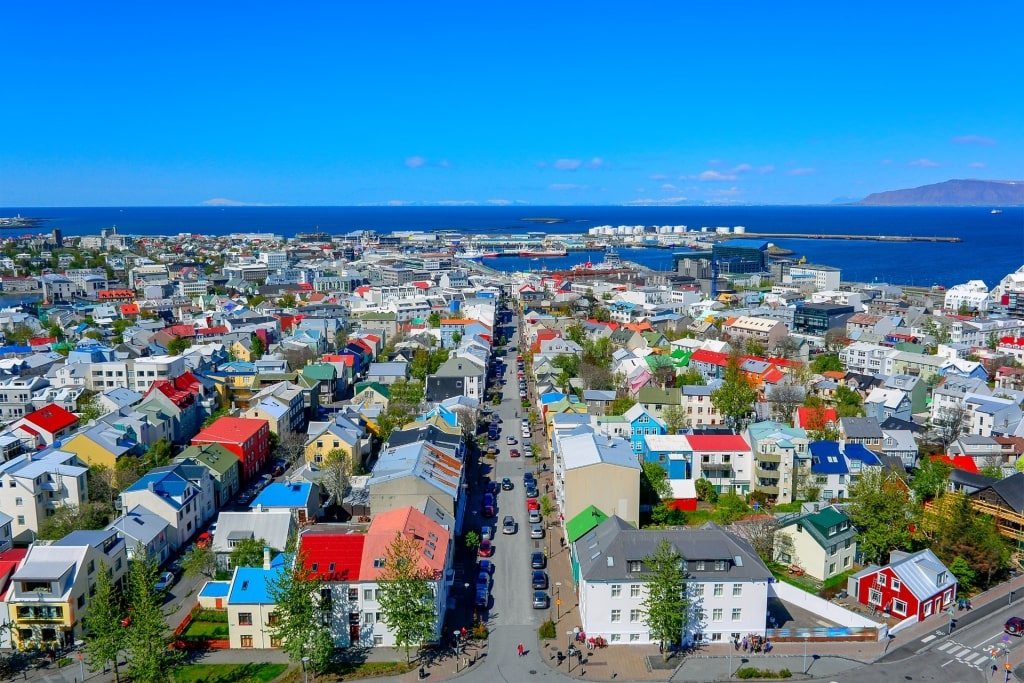
Downtown Reykjavik, Iceland
Accessibility and ease of traveling around Greenland vs Iceland will impact your choice of which to visit. For those interested in a self-driving tour to discover the sites, Iceland is the top choice as it has an efficient road network, although distances can be deceptively long.
Greenland is far more remote and simply doesn’t have the road system between villages like Iceland does. Traveling between destinations in Greenland is typically done by boat or air. You’d be unlikely to rent a car here.
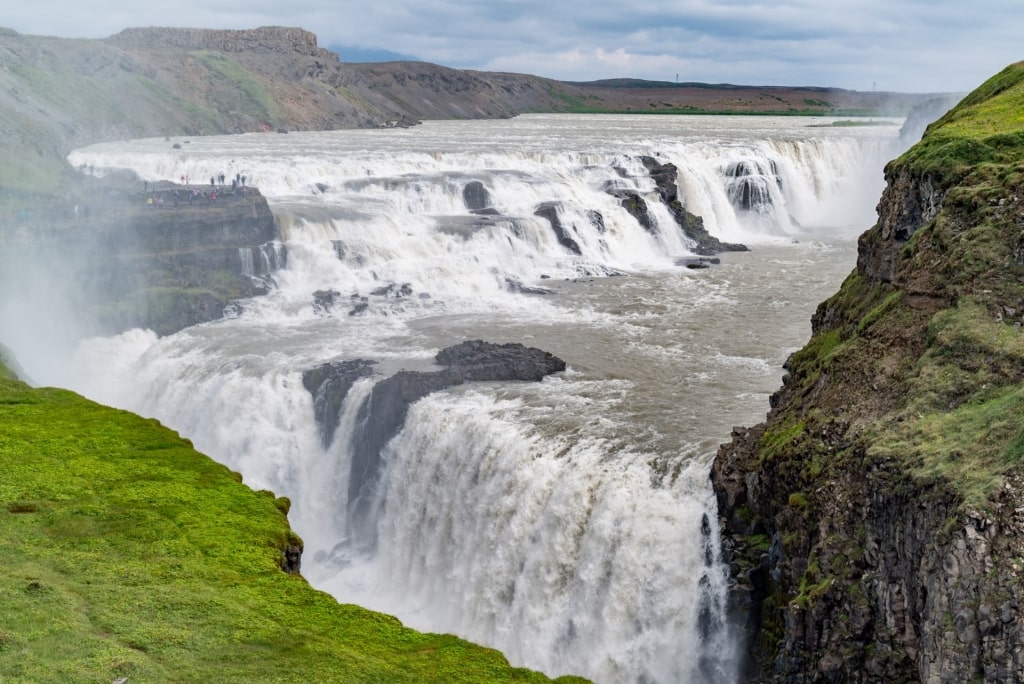
Gullfoss waterfall, Iceland
Discover Icelandic nature and historical points of interest by car or group tour, such as the famous Gullfoss waterfall or Thingvellir National Park. Known as “Golden Falls”, Gullfoss is one of the country’s top attractions.
This two-tier thundering waterfall is a sight to behold, fueled by the Langjokull Glacier in the Hvita River valley. It can be seen with a scenic hour-and-a-half drive from the capital city of Reykjavik.
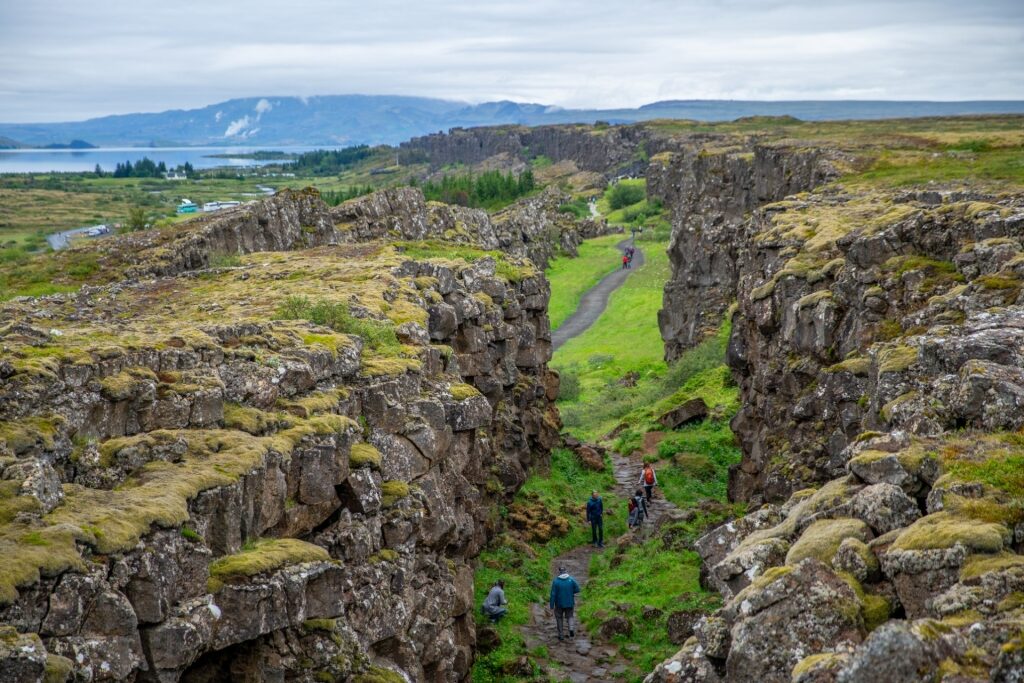
Thingvellir National Park, Iceland
Thingvellir National Park is one of the best places to visit in Iceland, reached within an hour from the city. The national park has been host to important historical events in Iceland since the 900s and provides an educational experience in nature for visitors.
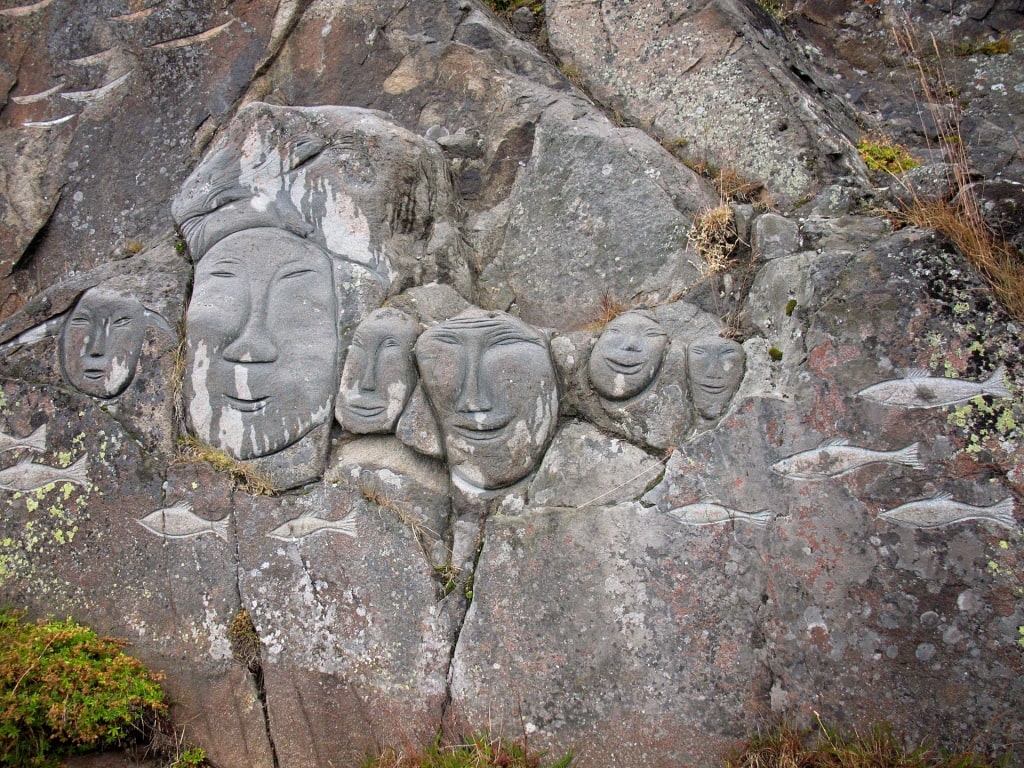
Stone and Man, Greenland
Despite being a bit more difficult to get around, Greenland has many accessible sites that can be reached by boat, car, or by walking from village centers. The southern village of Qaqortoq is a walkable open-air museum, with much to discover close by, including the famous Stone and Man art exhibit.
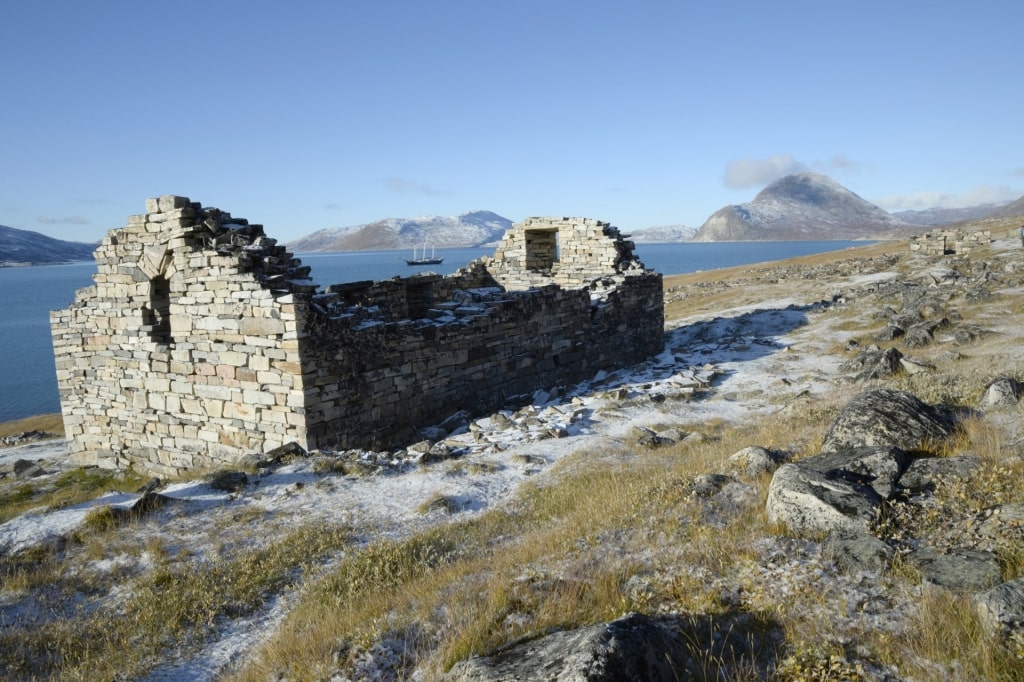
Hvalsey Church Ruins, Greenland
Visit the Qaqortoq Museum to learn about the history of the region, which is also the oldest building in town. Or take a boat from the harbor to visit the Hvalsey Church Ruins, a well-preserved UNESCO World Heritage Site with ruins that date back to the 12th century.
Natural Wonders
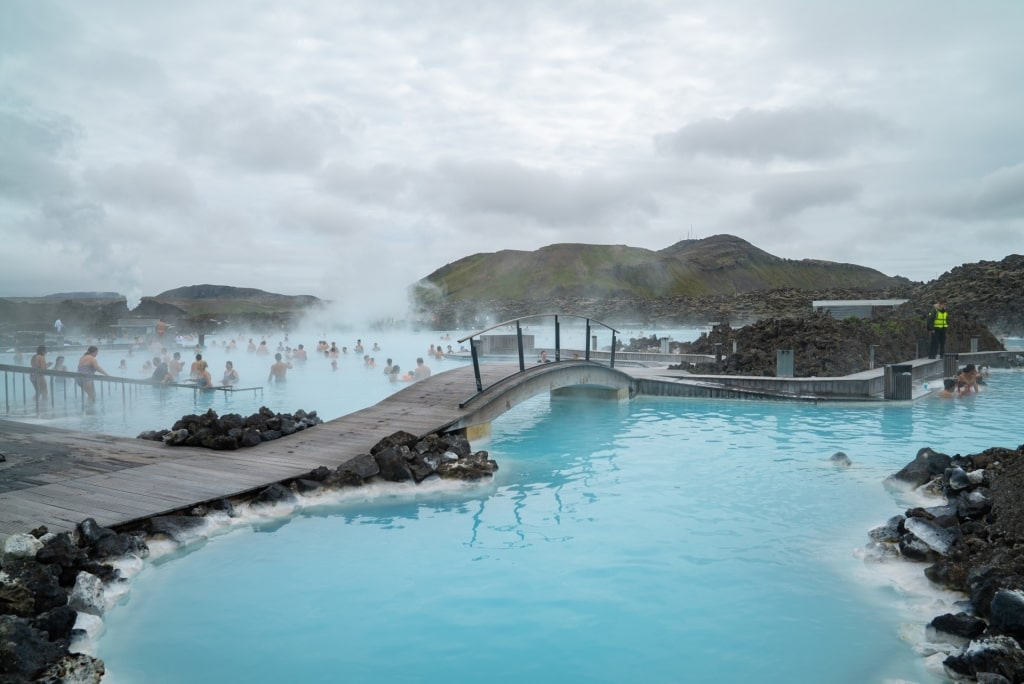
Blue Lagoon, Iceland
Both Iceland and Greenland have amazing natural wonders. Iceland is known for its black sand beaches, abundant glaciers and waterfalls, mountain ranges, and volcanoes. It’s also peppered with natural hot springs, perfect for soaking in the geothermal waters during your vacation.
A visit to the famous Blue Lagoon will allow you to experience the warm, healing waters of southwestern Iceland, where soaking provides health benefits for your skin.
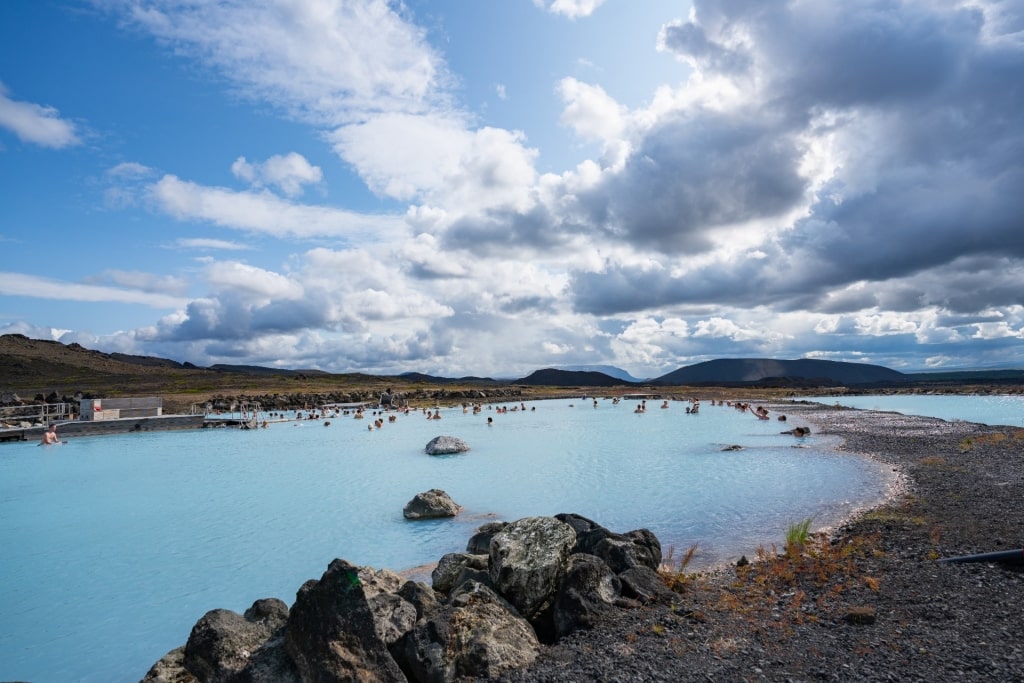
Myvatn Nature Baths, Iceland
In the northern part of the country, the Myvatn Nature Baths are another opportunity for soaking in the mineral-rich waters of one of Iceland’s best hot springs, located a little over an hour from the city of Akureyri.
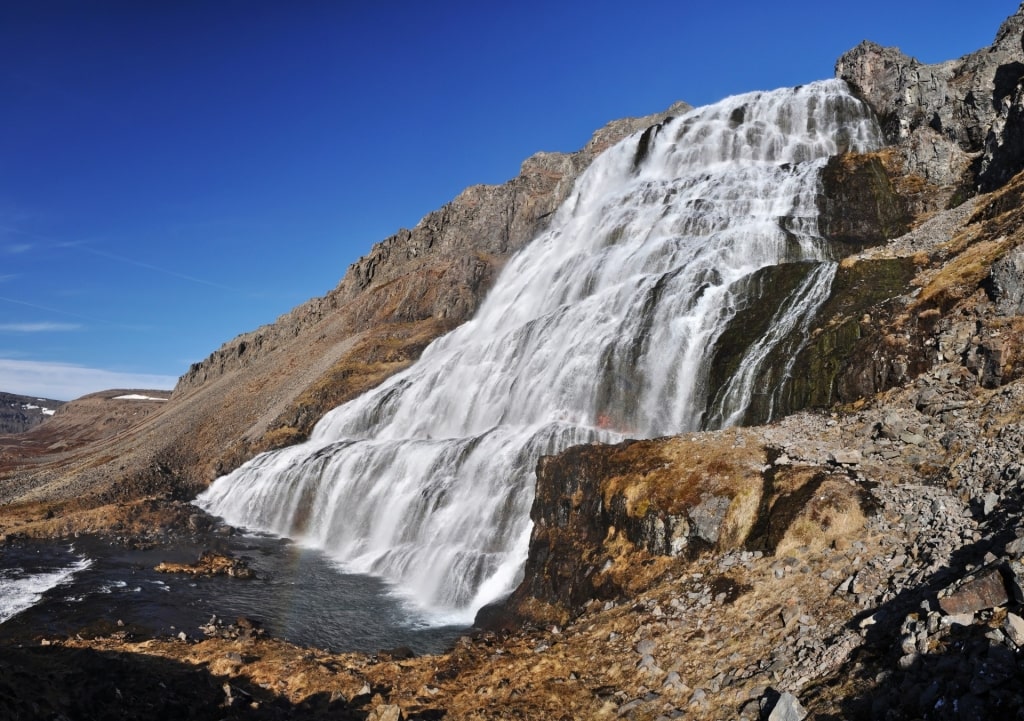
Dynjandi Waterfall, Iceland
Head to the Westfjords and discover more natural wonders; cascading Icelandic waterfalls are seemingly around every turn, and the “Jewel of the Westfjords” shouldn’t be missed. The 328-foot Dynjandi Waterfall is a set of impressive cascades reached by a hike that’s a one mile out and back.
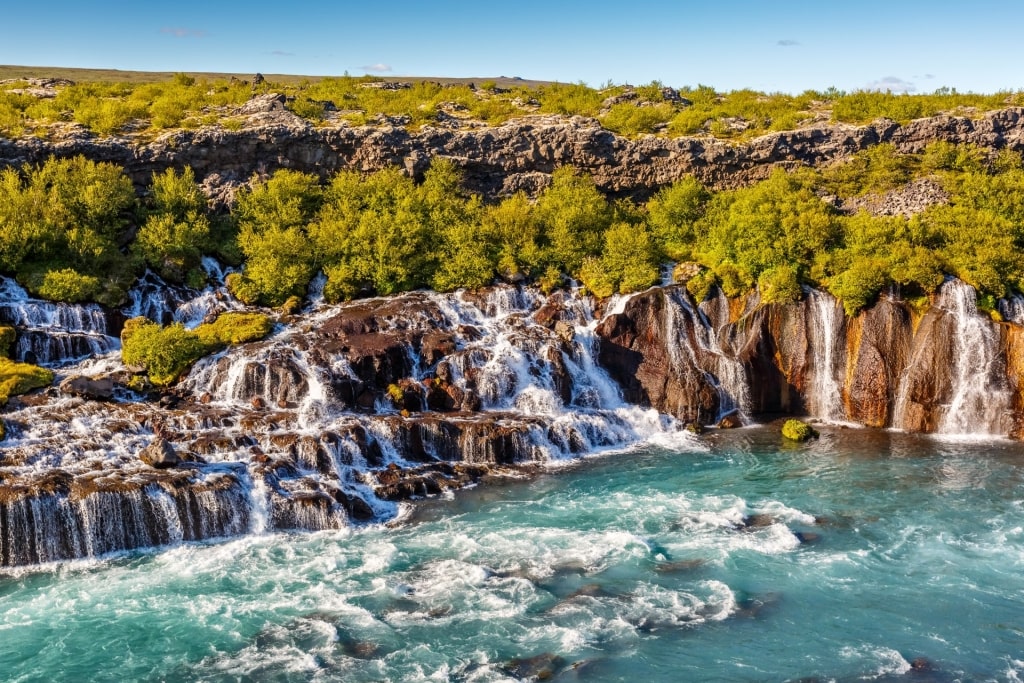
Hraunfossar waterfalls, Iceland
Venture to the contrasting Barnafoss and Hraunfossar waterfalls, located under two hours from Reykjavik in western Iceland. Barnafoss is associated with a tragic legend, in which two young children lost their lives in the foaming water.
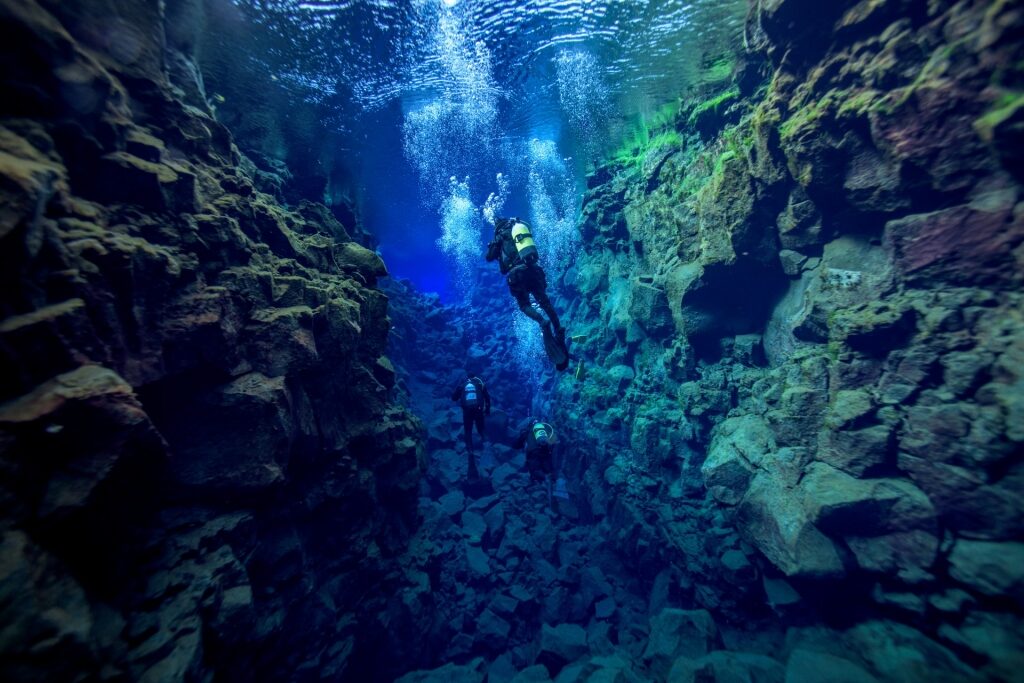
Silfra Fissure, Iceland
Iceland is also home to one of the most unique diving and snorkeling experiences in the entire world. Clad in a protective dry suit, you can swim between the North American and Eurasian tectonic plates in the astonishingly clear waters of the Silfra Fissure, one of the best diving spots in the world.
This natural wonder allows visitors to glide through glacial melt water, gazing at incredible rock formations and vivid shades of blue and green, with visibility often more than 100 yards.
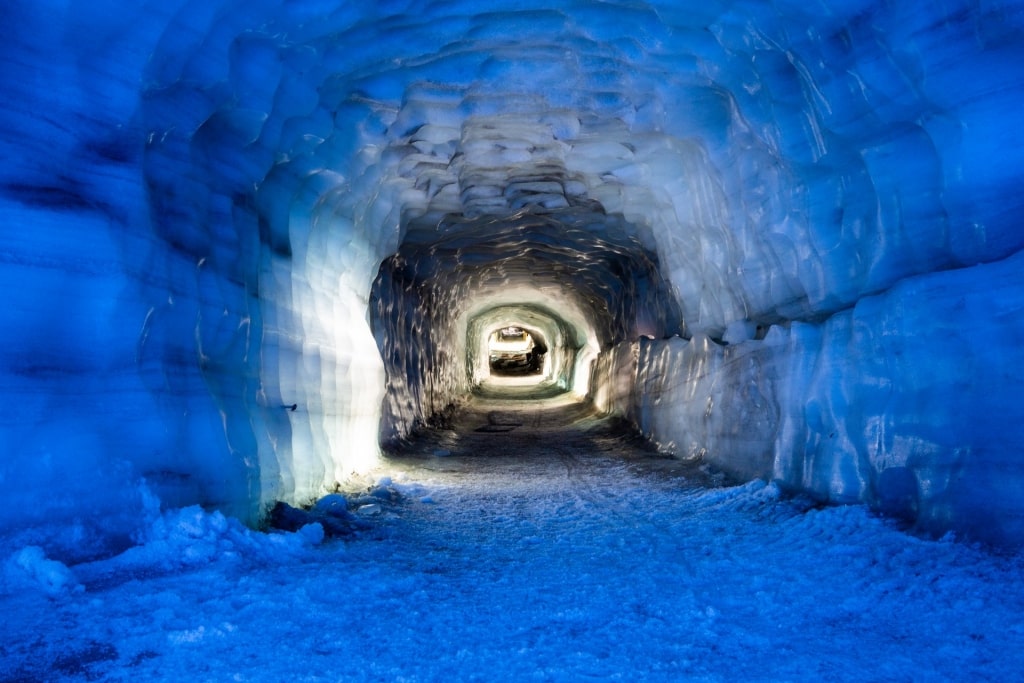
Langjokull Glacier, Iceland
Join a guided tour to embark on a glacier trek, or venture inside the glacier with a guide to explore one of the best caves in the world, along with tunnels and mysterious waterfalls actually inside the ice.
Greenland is also host to a wide array of natural wonders. From mountains and icebergs to waterfalls and fjords, the landscape is breathtaking, completely remote and unspoiled, with barely any industry.
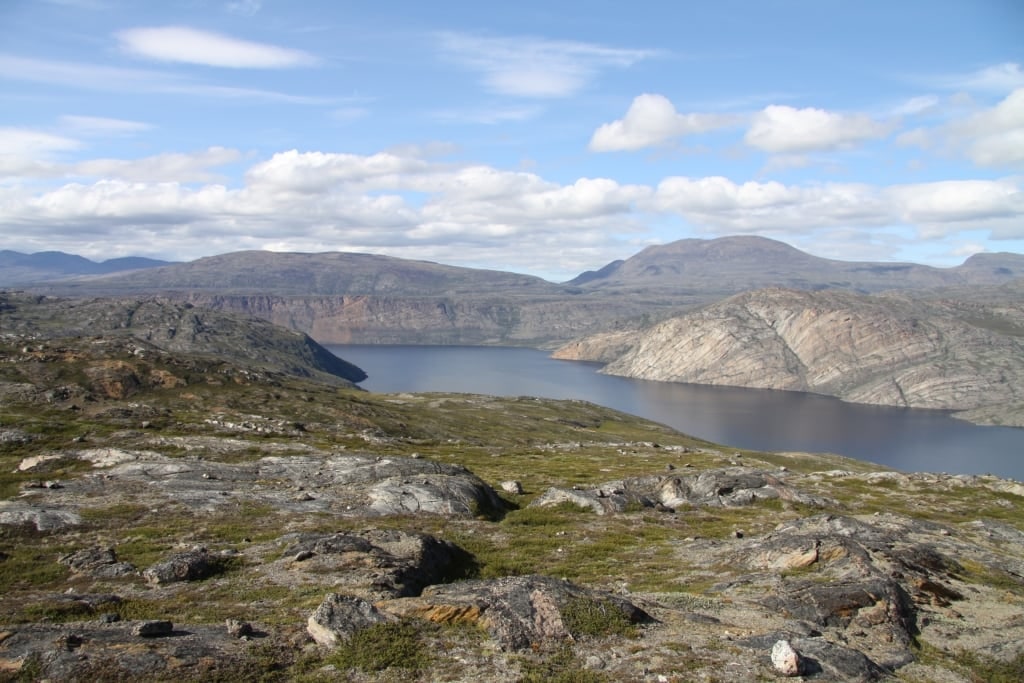
Lake Tasersuaq, Greenland Photo by Chmee2/Valtameri on Wikimedia Commons, licensed under CC BY 3.0
Waterfalls and glaciers provide some of the cleanest and most pure drinking water in the world. Hike to Qaqortoq’s main water source, Lake Tasersuaq, and discover one of the natural treasures in southern Greenland.
Created by an inland ice cap, this European lake is a popular spot for outdoor recreation, easily accessible from the village center. A six-mile loop trail is a great way to soak up the scenery of the lake and surrounding Pinju Mountains.
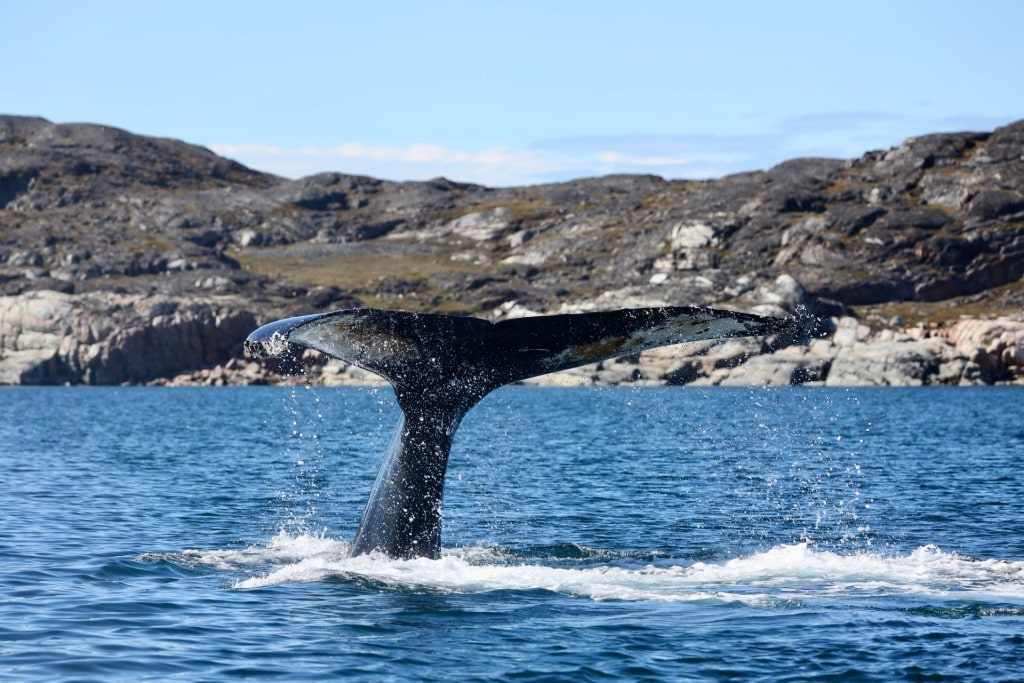
Humpback whale
Explore the fjords by boat or kayak and watch for icebergs and glaciers calving, and look out for whales. Greenland also has hot springs, though the nature of these differs from Iceland’s volcanic activity and the springs are fewer and farther between.
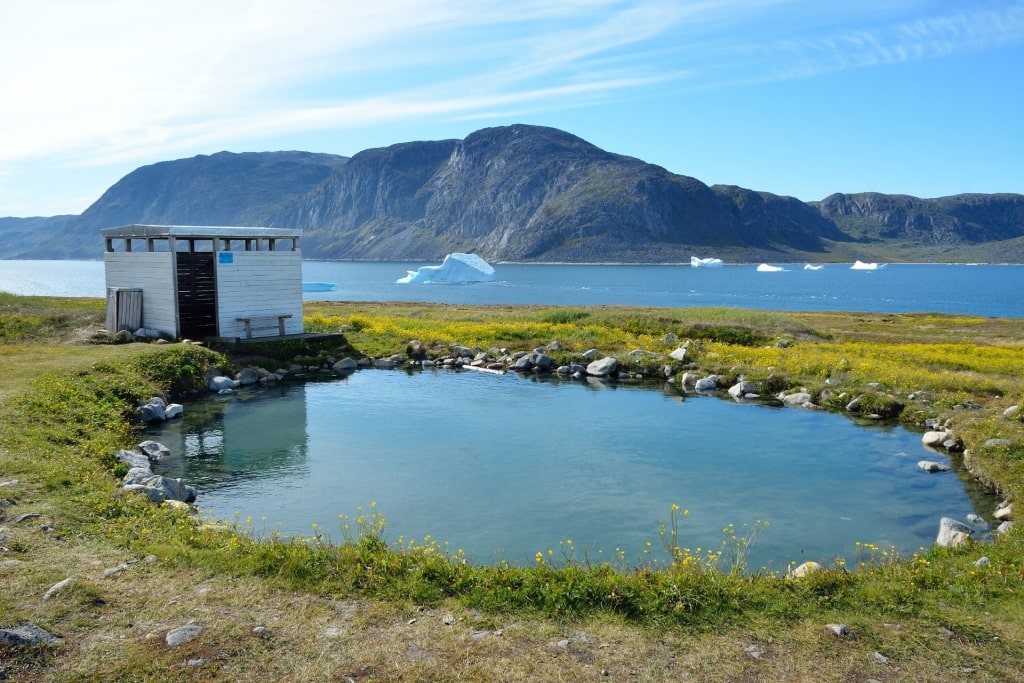
Uunartoq, Greenland
In Greenland, geothermal springs are warmed from the friction between layers of the Earth’s crust rubbing together. Visit the most popular hot spring with an hour boat ride to Uunartoq from Qaqortoq. Dip in the warm stone pool and gaze at the pristine alpine scenery.
Outdoor Adventures
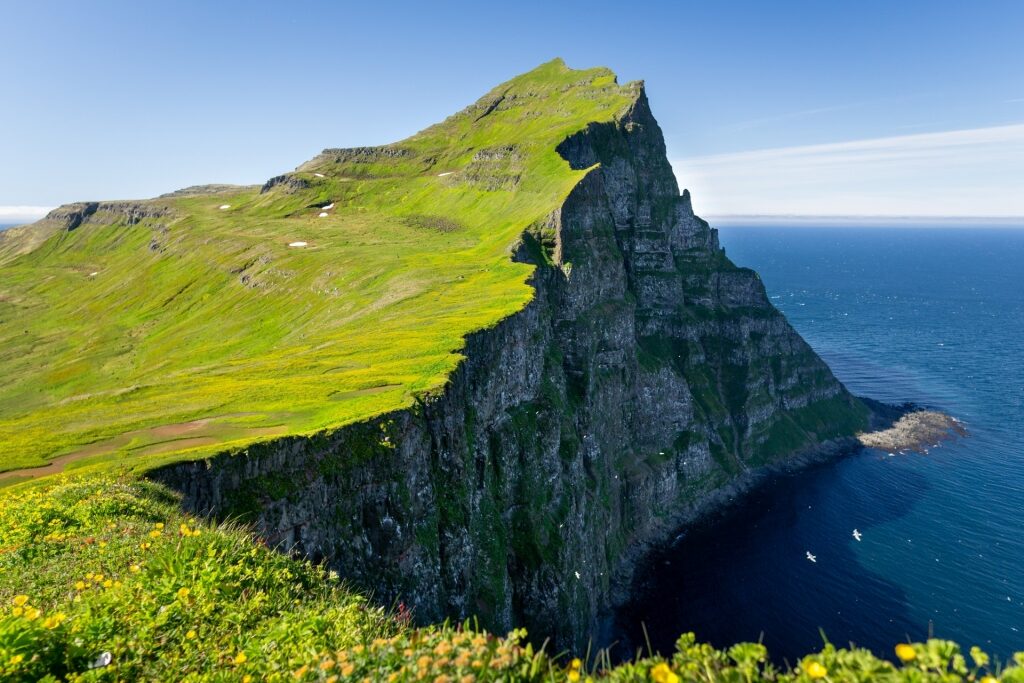
Hornstrandir Nature Reserve, Iceland
Greenland and Iceland are both paradise for outdoor lovers, with vast terrain to explore by hiking, paddling, and more.
While hiking in Iceland, travelers will be delighted by the wide array of diverse terrain to choose from, whether hiking to a waterfall like Glymur Waterfall, trekking on glaciers, walking in the shadow of dormant volcanoes, or discovering the abandoned village of Hesteyri in Hornstrandir Nature Reserve.
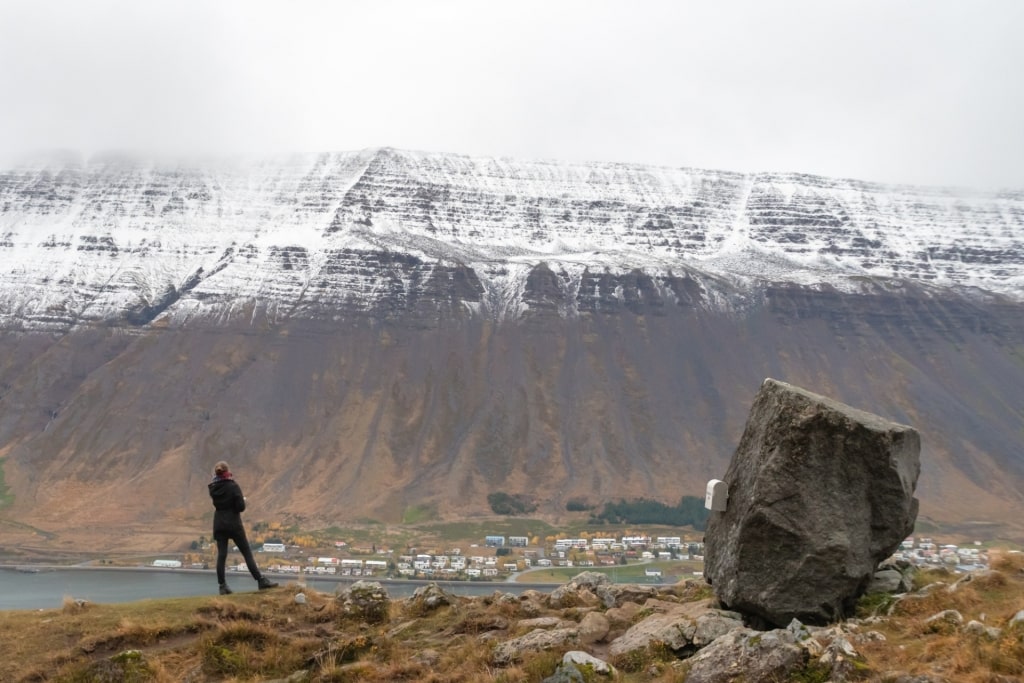
Nuastahivilft Rock Formation, Iceland
Maximize your views in the Westfjords region with a hike up Nuastahivilft rock formation, just outside of Isafjordur. Known as “The Troll Seat” according to a local legend, this short trek rewards in a big way with a vista overlooking the village and bay below.
Kayaking in calm fjord waters and other adrenaline-inducing activities such as ATV tours, horseback riding, cave touring, and ice-climbing are all possible as well.
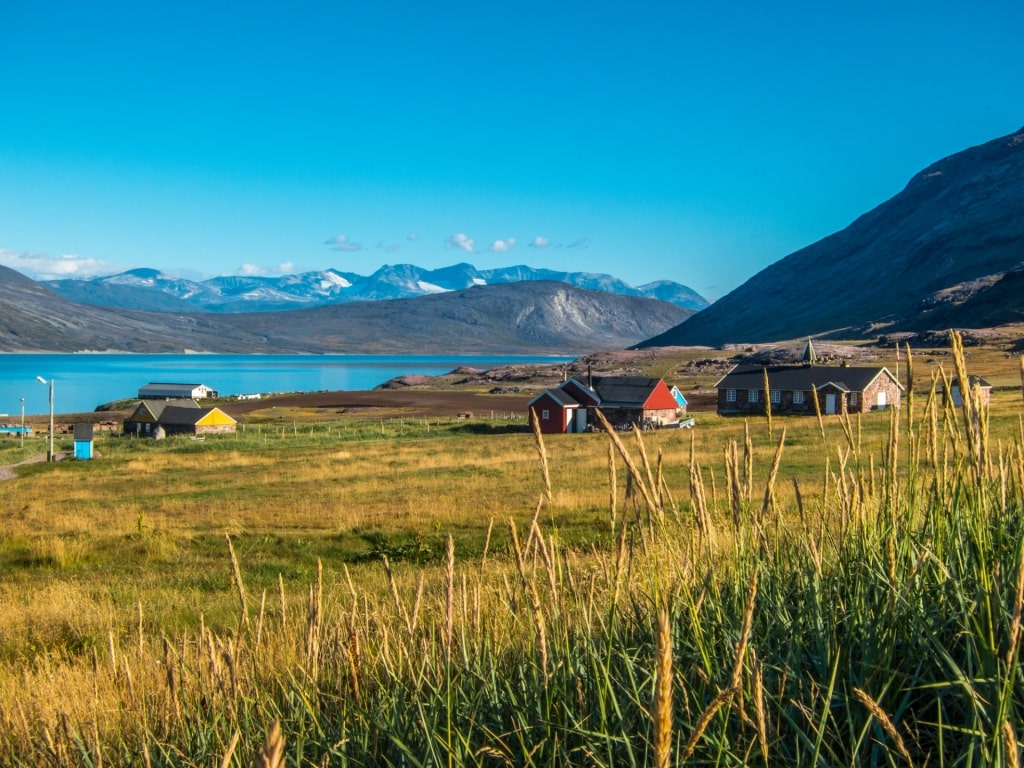
Igaliku, Greenland
Meanwhile, hiking, kayaking, and fishing are some of the best things to do in Greenland. Hike the network of trails in the sheep farming community of Igaliku, dating back to the 1700s.
This area is accessible with a boat ride from Qaqortoq and offers a good opportunity to experience local culture in the small village, as well as the beautiful natural setting.
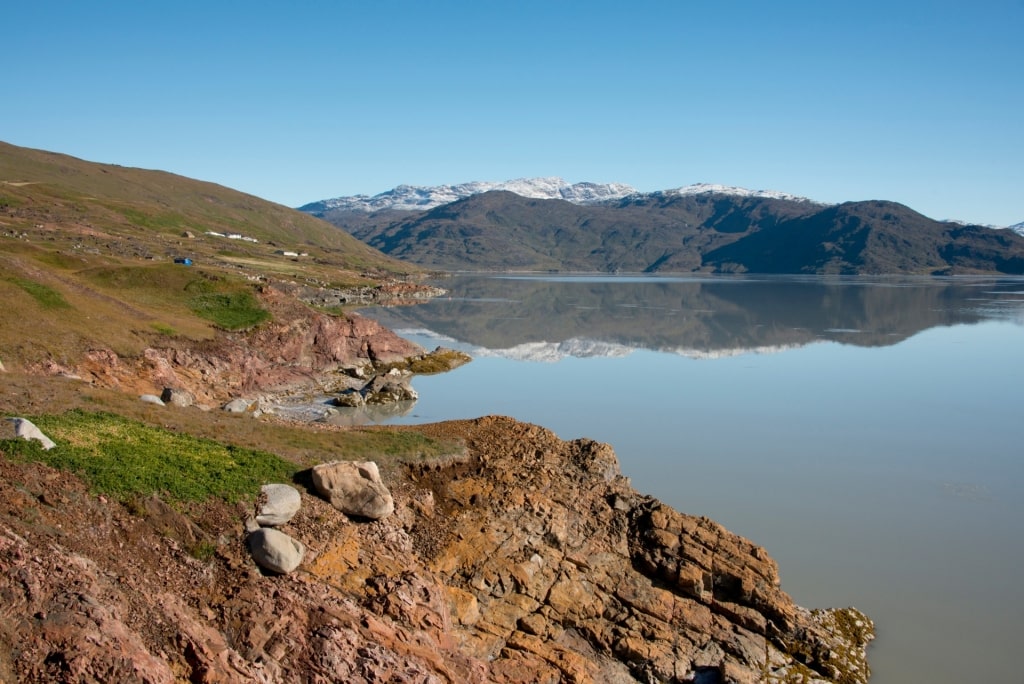
Tunulliarfik Fjord, Greenland
Take in the views of the Qoornoq Glacier and Tunulliarfik Fjord along the Lake and Plateau Trail. Cast a line in Narsaq along the Ilua River, fed from a glacial ice cap, where you’ll have the chance to catch Arctic char. Or, head out on a boat to try your hand at deep sea fishing, where you can catch cod, redfish, or trout.
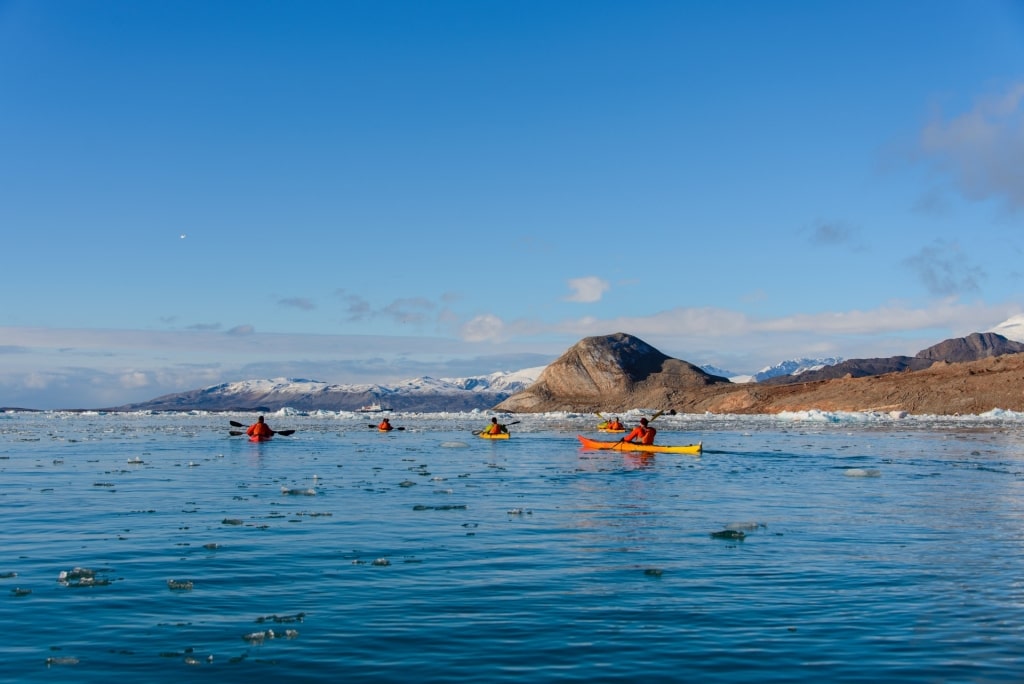
Kayaking in Greenland
Kayaking originated in the Arctic region and is an activity that shouldn’t be missed while visiting Greenland, particularly for its cultural ties to the country. It has long since been a method of transportation and tool for hunting and fishing in the scenic fjords.
One of Europe’s most unique places, Qaqortoq is situated amongst a network of fjords that can be explored by kayak. Keep an eye out for seals, whales, birds, and icebergs as you enjoy your paddling adventure.
Wildlife
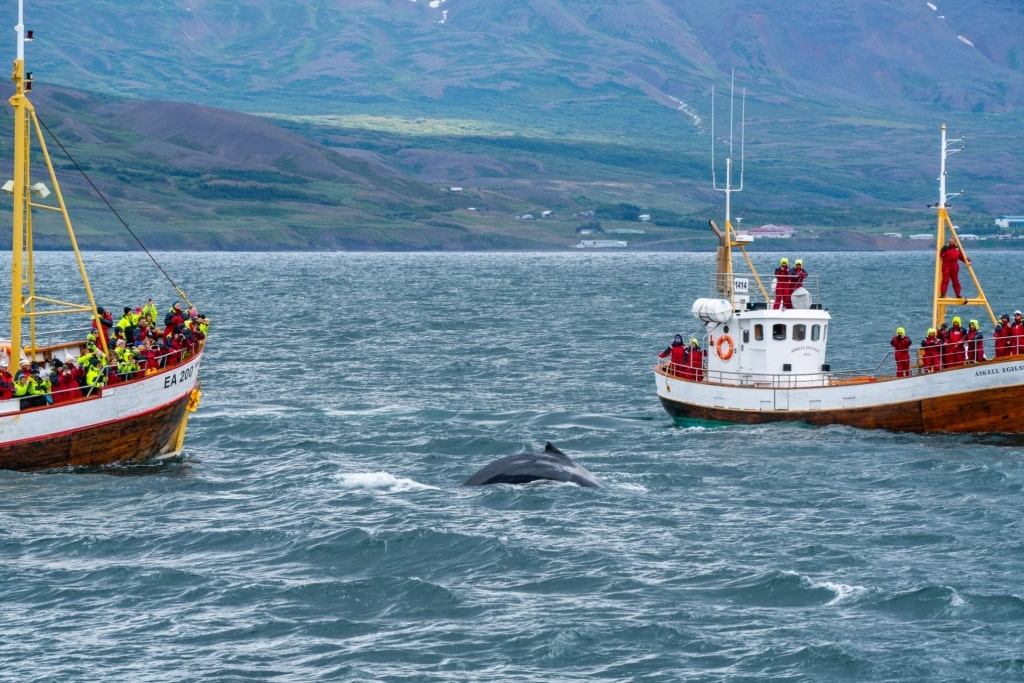
Whale-watching in Iceland
Both Greenland and Iceland are home to unique Arctic wildlife species. Each country offers travelers the opportunity to view and learn about the different animals in their natural habitats. In both countries, whale-watching is a popular activity.
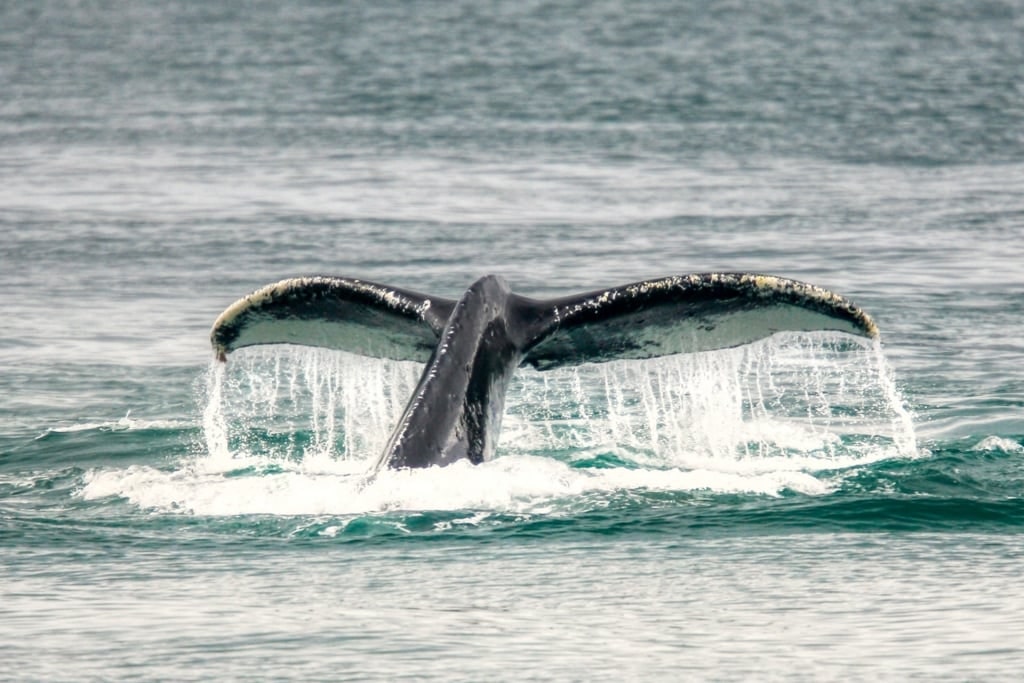
Humpback whale
The main difference is that in Iceland, you will most likely need to head out on a boat to view the wide array of whale species that inhabit the waters surrounding the country.
In Greenland, it’s possible to see them from shore as well. Humpback, minke, pilot, orca, and many more types of whales can be viewed in Iceland.
In Greenland, you might spot one of 16 species of whale, including blue, fin, and humpback whales, or even the mystical narwhal.
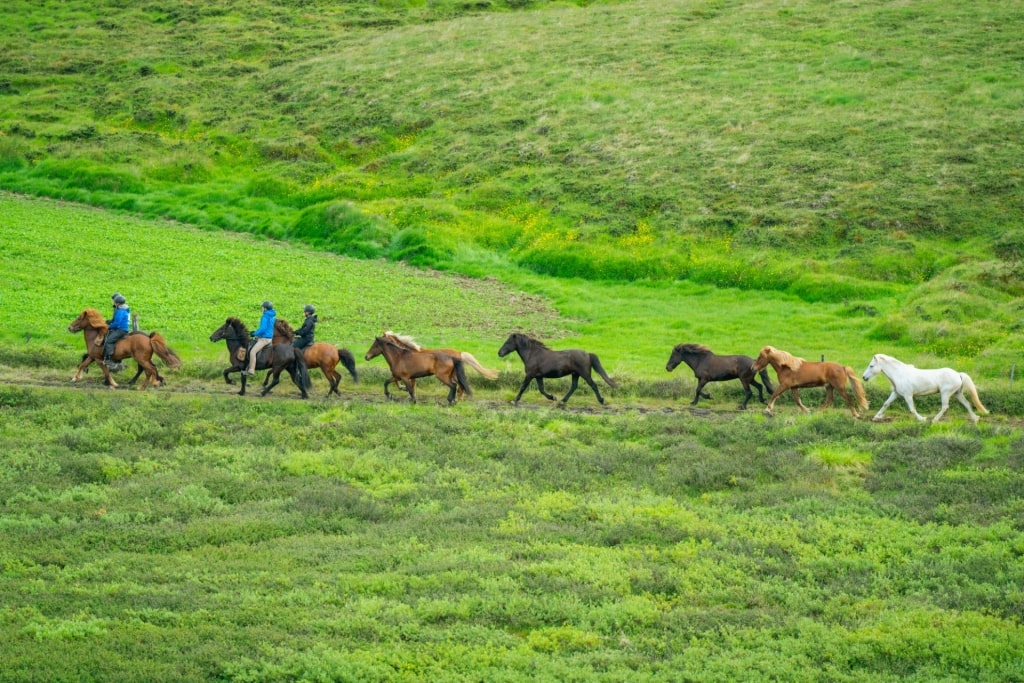
Icelandic horses
Other Icelandic wildlife includes the Icelandic horse, puffins, sheep, and Arctic foxes. Visit the small fishing village of Sudavik in the Westfjords region where you can learn about the Arctic fox population in Iceland through a series of exhibits at the Arctic Fox Center.
Get close to the gorgeous Icelandic horse breed with a guided horseback ride through the country’s dramatic terrain.
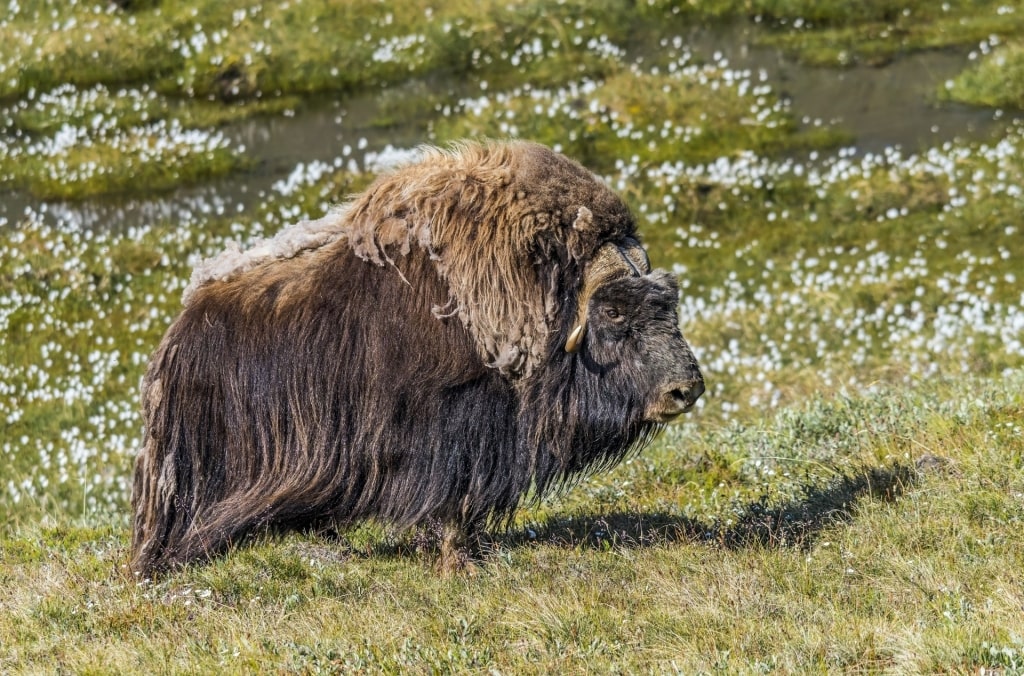
Musk ox
Greenland is home to musk ox, seals, and even polar bears. View seals and Arctic birds such as the white-tailed eagle, Atlantic puffin, or cormorant while kayaking the fjords surrounding Qaqortoq.
History & Culture
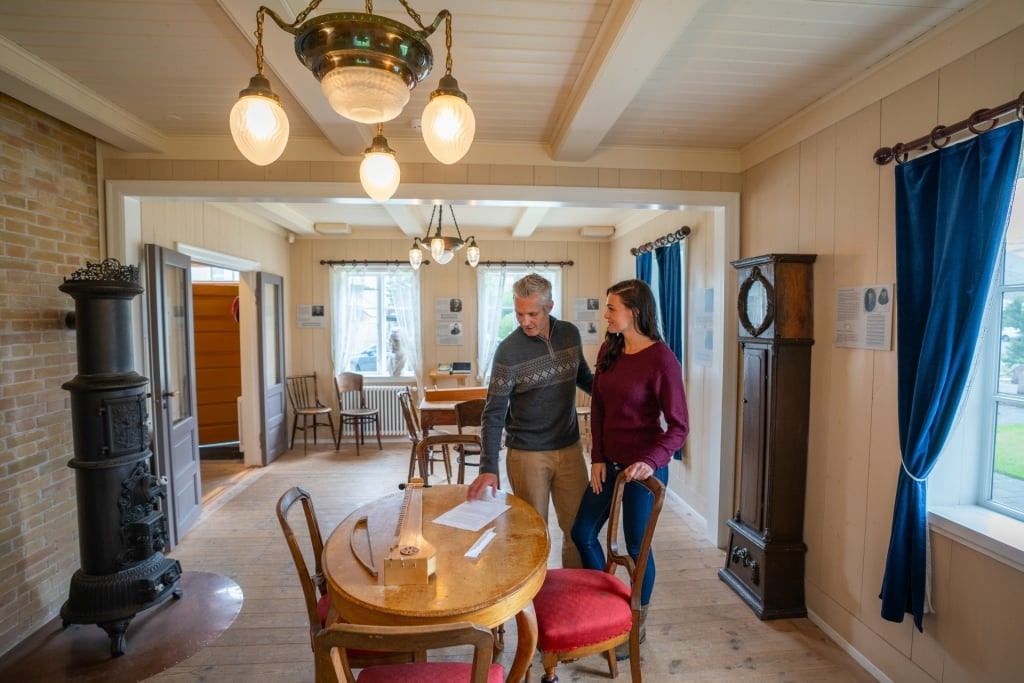
Folk Music Center, Iceland
Although both countries are tied together historically by Viking explorer and settler Erik the Red, they have different backgrounds and are culturally different in many ways, including language.
Icelandic is the official language in Iceland, although many people speak excellent English. In Greenland, people speak Greenlandic, an Inuit language, with three dialects. English is much less spoken.
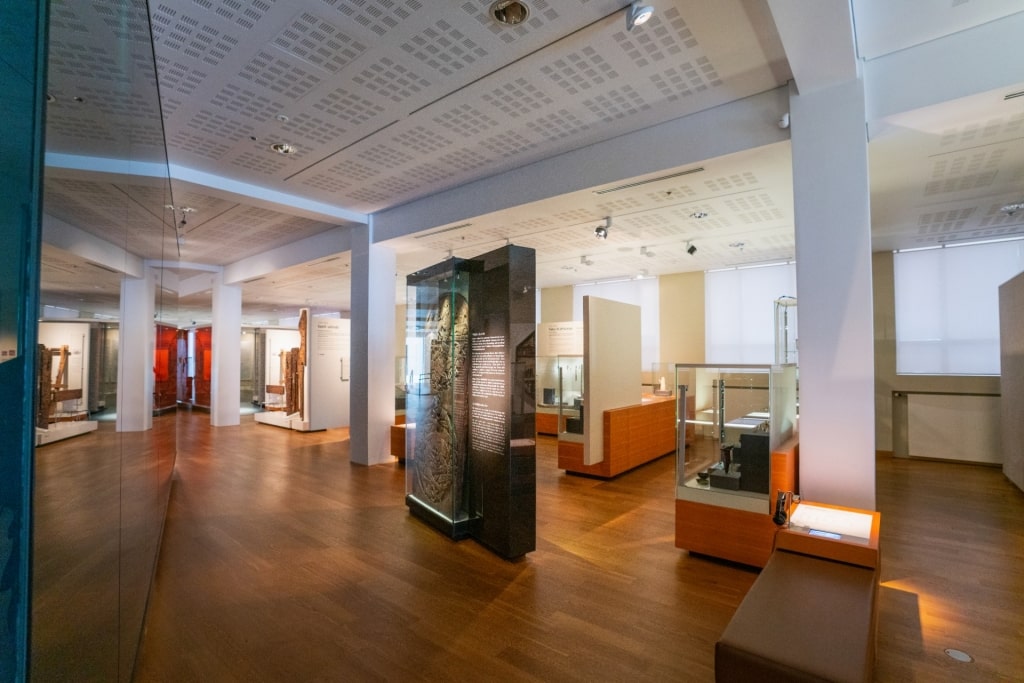
National Museum of Iceland
In Iceland, you’ll have the opportunity to learn about Viking heritage and the many legends tied to folklore. One of the best things to do in Reykjavik is to explore the myriad museums that detail the country’s history and culture.
Stop into the Maritime Museum near Downtown Reykjavik, or view the educational exhibits in the National Museum of Iceland, which focuses on the country’s cultural history.
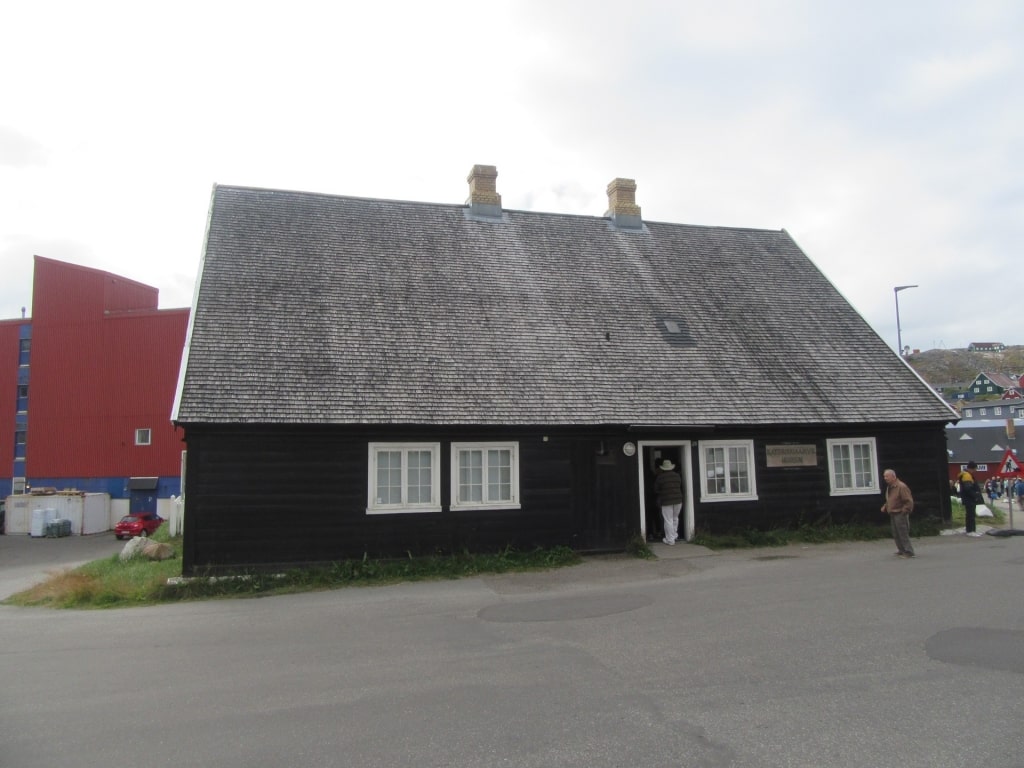
Qaqortoq Museum Photo by amanderson2 on Flickr, licensed under CC BY 2.0
In Greenland, the historical focus is on the Inuit people and indigenous groups, as well as the subsistence activity of hunting and fishing over the centuries. Explore the Qaqortoq Museum, located in the center of town in the oldest building, dating back to the early 1800s.
Wander the Red Room and Blue Room, and learn about the history of the Norse settlers as well as view ancient harpoons, kayaks, and a traditional, reconstructed hut.
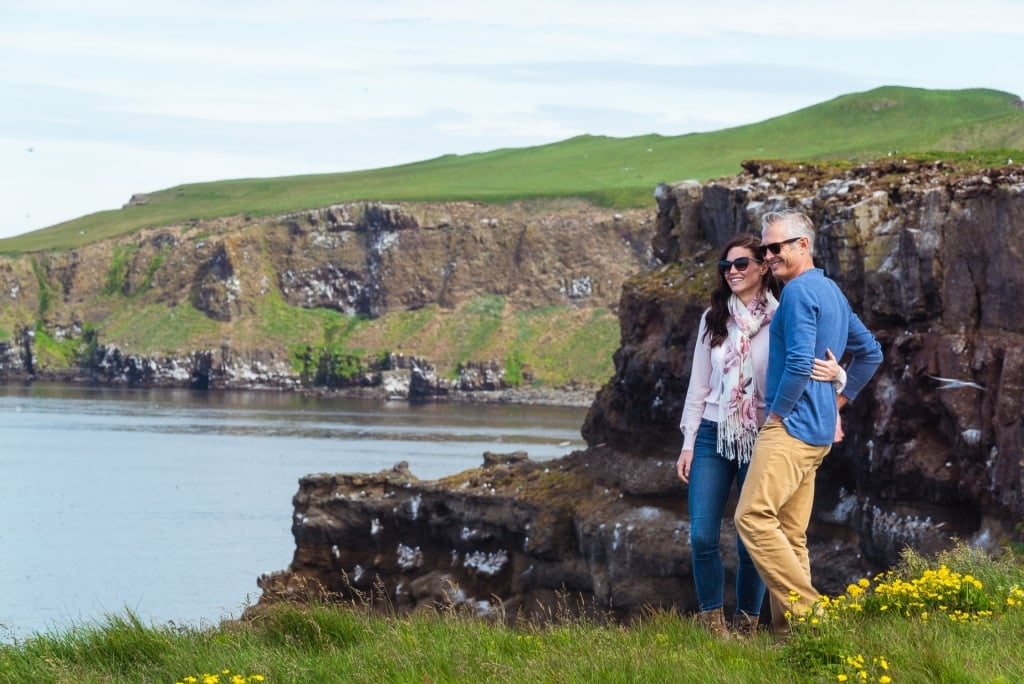
Grimsey Island, Iceland
If it’s a choice of Greenland vs. Iceland, you could have a difficult decision, with both countries offering beautifully unique landscapes and abundant outdoor experiences.
Luckily, you can plan a thrilling escape that includes both destinations. A cruise with Celebrity that visits Greenland and Iceland in one incredible vacation is a fantastic way to discover all that they have to offer. Browse our cruises to Iceland and Greenland and book your Arctic adventure today.
